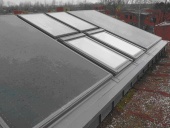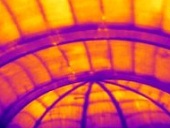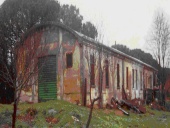The last revision of STN 73 0540 came in the validity in 2002. The requirement on minimum energy performance of buildings influenced heat need for heating by decreasing of 28.6 % comparing with the requirement of valid standard. The recast of the directive issued as directive 2010/31/EU required further decreasing of energy use for heating. To achieve the required stage in energy performance of buildings also changes in thermal protection properties are needed.
Archiv článků od 21.2.2011 do 12.9.2011
The major damages in concrete structures caused by fire are a breach of the concrete strength, the cracking, peeling, discoloration and deformation of elements. The most important are reduction in concrete strength becomes associated with its subsequent bursting. Although quantification of the main changes of the strength is unreal, it is possible to determine its damage by measuring the speed of ultrasound.
Experience of construction supervision show that expectations for the revitalization and rehabilitation of housing, which includes regeneration or at least repair of residential buildings are not completely fulfilled in practice. At the same time shows how the robust technical supervision for quality of work is important.
Within the grant project "Multi-storey buildings made of wood" in the laboratories of the Academy of Sciences in Prague and TAZUS performed number of tests of wooden skeleton joints with steel plates, which confirmed the theoretical assumptions and calculations, and demonstrate their reliability and functional and economic advantages for use in practice. Here are a few of the results of experimental tests.
The aim of the research was to determine the effect of chemical degradation of the surface layers of wooden structural elements to their mechanical properties and depth to which the damage extends. Degradation of the surface layer of wood structural elements caused a chemical reaction of some compounds contained in the fire in the past repeatedly coatings applied to wood structures of historical buildings. Such chemicals include ammonium sulphate and ammonium phosphate.
Z1 Change of the standard ČSN 73 0580-1 Daylighting in buildings - Part 1: Basic Requierements was issued in January of this year. The standard itself is valid since June 2007. Z1 Change does not bring major changes, however, it specifies the text of some articles, especially the methodology of the assessment of shielding with regard to shielding by the constructions of the same building.
Comparison of knowledge in the field of wooden buildings between the CR and abroad is especially based on the author's many foreign visitors of completed buildings, businesses and universities, the knowledge of the extent and quality of especially American and German literature and participation in many international conferences, including the last World Congress of timber engineering WCTE, held in June 2010 in Italy.
Nowadays there is a growing interest in quality and high energy saving housing. The following article presents the almost unusual renovation of a terraced building in Denmark. It was expected that after the renovation the building with become CO2 neutral. The last house of a terrace in the twon of Albertslund, Denmakr was chosen for the renovation. It had been built in the 1960's and it is a two story terraced house with a 50m2 footprint.
This paper is focused to the fire resistance of multi-storey buildings with light wooden skeleton. Computational procedures in Eurocode are applicable simply and only for a limited number of building elements. For scientific work in this topic are indispensable fire experiments and their subsequent evaluation by means of numerical and analytical models.
In January I published an article about the upcoming revision of CSN 73 0540-2 Thermal protection of buildings, Part 2: Requirements. I expressed to changes in each individual chapter. Since then there is new development in the standard revision. Some comments by members of the Standardisation Committee No. 43 and by professionals from the April public consultation of the standard were implemented. Some chapters of the standard are nearly unchanged since January, but some have changed in fairly major way.
Wood pieces, even locally damaged exhibit useful stiffness and strength parameters with which they can help continue to meet current requirements - after repair. Experience with old wooden structures such as roofs of church towers demonstrate the ability of timber stored in a suitable environment to retain its material properties for many centuries.
The hot-air treatment of the roof truss of the Upper Church in the village of Velká Lhota at Dačice is documented in stepwise details as a graphical and textual presentation with supporting charts and photographs. In addition to a mycological analysis, a project preparation plan and the main heat treatment technology, a detailed operations schedule is introduced as well as temperature measurement, supporting constructions and heat penetration. The writers’ utmost objectiveness towards this method is demonstrated by thermal camera images of the critical sites and cavities attacked by fungi. The article provides a comprehensive overview of application practices with all necessary recommendations, including the final application of chemical preservatives on the already heat-treated wooden framing.
Coloured photovoltaic cells are occasionally used in architectural applications. Their wider utilisation is currently limited by the lower efficiency compared to cells with an optimal anti-reflective coating. Research is focused on desing and manufacturing of anti-reflective coating, which besides of required color will have minimised the reflection in the infrared.
In 2007 the group GAIA SpA got an idea from Massimo Fiorini (an amateur builder) to reconstruct the delapidated Marconi Laboratories in Coltrano, near Pisa (Italy) and turn it into EneryPlus terraced passive houses. The group was fully convinced after a visit to the ASSA passive office building in Santa Croce Sull'Arno, and in 2008 they began the design works. The building turned out to be appropriate to be turned into a passive house project. However, the problem was listed in the highest heritage class, which had been granted not for the importance of the building itself, but as part of a listed group. The planning had to be very detailed. Another problem was the arched concrete roof, which was extremely vulnerable to collapse. The Heritage Protection Office in Pisa was at first very sceptical with the project, but in the end they were convinced about the interest and the quality of the project after a series of meetings with the builders and the representatives of TBZ.
Over 5000 buildings in Austria have been constructed in the passive standard. In the future, a considerable part of new constructions should be build in the passive standard. The goal is to have all subsidised residential buildings built in the passive standard by 2015. The aim of the study was to learn from the first residential complexes of passive buildings. The main questions were: Do the passive buildings meet the ambitious expetations of the project? How satisfied are the people living in them? What additional construction costs can be expected and what are the actual energy savings compared to conventional residential complexes?
The paper discusses the alternative heat sources to central district heating for panel buildings. Nowadays, most of the reconstructions of panel buildings cover only the improvement of thermal quality of the building envelope in order to decrease the heat loss and the operating costs of heating. With high-quality insulated envelope it is possible to achieve high reduction of thermal heat loss. Additional reduction of heat loss on the envelope insulation side is very expensive. In order to reach another reduction of operational costs in the building it could be more efficient to change the heat source with cheaper energy.
As in other countries, in Norway energy remediation is carried out mostly on an average level. For a decade, this has blocked highly effective energy saving measures in public housing because better energy remediation measures pay off only after a long time. Myhrerenga is the first block of flats in Norway renovated according a passive house concept.
The article describes some of the results of the research project R&D SP3g522107 – Full renovation of panel buildings in the low energy standard, which was carried out by EkoWATT with the support of the Ministry of the Environment in the years 2007-2010. One of the main instruments described is the parametric model, which allows the evaluation of a large sample of virtually generated building probabilistic methods, a case study of a renovation of a panel building to a passive standard using a grant with a 8 year investment return and also, an internet application that easily allows to add a panel building to a computer model and test the effects of the saving measures.
Czech method for building quality classification SBToolCZ and the first certificated building X-LOFT
One of the way how to recognize quality of buildings are methods for sustainable buildings classification. SBToolCZ is a certification method for complex building quality classification according to sustainable buildings principles – including environmental, social and economic criterions. The SBToolCZ method is based on the international SBTool system. Criterions and requirements are being modified according to standards development on the international level. SBToolCZ was developed on Faculty of civil engineering (Czech Technical University Prague), CIDEAS centre.
zpět na aktuální články



















